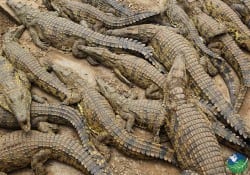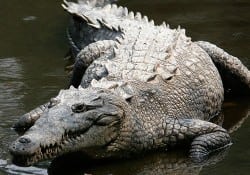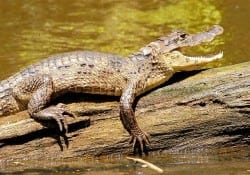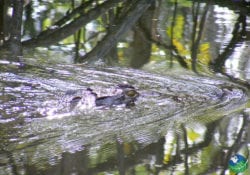Crocodiles in Costa Rica
 Costa Rica is the land of biodiversity and the abundance of wildlife is often people’s first reason to visit this beautiful country. The long list of fascinating creatures also includes a wide range of crocodiles and caiman. With the average crocodiles in Costa Rica reaching sizes 2 to 3 meters and the caiman between 1 and 5 meters, you won’t have too many difficulties spotting them. That being said, it can be easy to confuse a floating piece of driftwood for a crocodile.
Costa Rica is the land of biodiversity and the abundance of wildlife is often people’s first reason to visit this beautiful country. The long list of fascinating creatures also includes a wide range of crocodiles and caiman. With the average crocodiles in Costa Rica reaching sizes 2 to 3 meters and the caiman between 1 and 5 meters, you won’t have too many difficulties spotting them. That being said, it can be easy to confuse a floating piece of driftwood for a crocodile.
Because issues with hunting, loss of habitat and pollution, the crocodile population had been dwindling. In some areas in Central America and the rest of the continents, they were even considered endangered. In Costa Rica they currently hold the status of Vulnerable while the caiman has moved up to Least Concern.
Behavior
 Crocodiles and caimans are carnivorous and eat only meat. They will eat anything they can get catch from birds to fish, iguanas, turtles, deer and yes, even humans. They tend to frequent river beds and can lay in the sun for hours to get their body temperature back under control after hunting in the cold waters.
Crocodiles and caimans are carnivorous and eat only meat. They will eat anything they can get catch from birds to fish, iguanas, turtles, deer and yes, even humans. They tend to frequent river beds and can lay in the sun for hours to get their body temperature back under control after hunting in the cold waters.
Due to their tolerance of salt water, crocodiles are pretty flexible when it comes to their living area. They reside in rivers, swamps, lagoons, small islands, and have been known to come up onto the beach every now and again. Caimans are a little more picky about where they want to live and are mainly found in rivers, mangroves and canals.
Crocodiles are the only reptiles to maintain a nest after they lay eggs. They will either dig smaller holes in which to lay the eggs, or create what is called a mound nest where the eggs are covered with mud and dirt that will harden and create a protective layer.
Where to see Crocodiles and Caimans in Costa Rica
- The best spot in all Costa Rica to see crocodiles is the Tarcoles River Bridge. Here you won’t just see a couple of crocodiles, but
 hundreds of them. Tarcoles river is located on the road towards Jaco on the Central Pacific side of Costa Rica. It isn’t a beautiful river but certainly it is amazing to see the monsters below. You can also take the famous Crocodile Man Tour on this river!
hundreds of them. Tarcoles river is located on the road towards Jaco on the Central Pacific side of Costa Rica. It isn’t a beautiful river but certainly it is amazing to see the monsters below. You can also take the famous Crocodile Man Tour on this river! - Some of the most popular spots to see these caimans are in the canals of Costa Rica. Tortuguero is one of the most popular points to see them, they thrive within the Canal waters edge. You can also travel down towards the Sierpe Wetlands, where they thrive in the wetlands and canals.
- Palo Verde National Park isn’t only a great birding destination. You can also take a boating tour just to see crocodile and caiman drying in the sun.
The two species don’t really like to mix and mingle but and are very territorial. So, where you see crocodiles you generally won’t see caimans.

 hundreds of them. Tarcoles river is located on the road towards
hundreds of them. Tarcoles river is located on the road towards 



 Chances are you are in for a bit of fun that doesn’t involve you seeing a giant crocodile. And there are certain places in Costa Rica where you won’t really expect to see them and where you should take extra care. They might not specifically hunt for humans, but they won’t hesitate to catch an easy prey!
Chances are you are in for a bit of fun that doesn’t involve you seeing a giant crocodile. And there are certain places in Costa Rica where you won’t really expect to see them and where you should take extra care. They might not specifically hunt for humans, but they won’t hesitate to catch an easy prey!





Follow Us